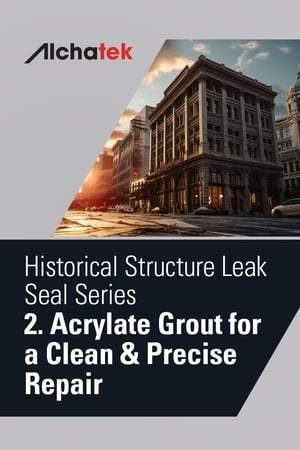
 In the realm of historical structure preservation, acrylate grouts have become an essential tool. But what are they, precisely? Acrylate grouts are water-soluble resins that transform into a gel-like substance when mixed with specific catalysts. Renowned for their flexibility, strength, and compatibility with a broad range of building materials, these grouts are particularly suited to older buildings where traditional repair materials may fall short.
In the realm of historical structure preservation, acrylate grouts have become an essential tool. But what are they, precisely? Acrylate grouts are water-soluble resins that transform into a gel-like substance when mixed with specific catalysts. Renowned for their flexibility, strength, and compatibility with a broad range of building materials, these grouts are particularly suited to older buildings where traditional repair materials may fall short.
Acrylate Grouts in Action
In historical buildings, acrylate grouts play a pivotal role, especially in the following applications:
- Crack Injection: Here, acrylate grouts are injected into existing cracks. They bond with the material and seal the crack from within, precisely curing without impacting adjacent areas.
- Curtain Grouting: This method involves creating a 'curtain' of grout behind a wall or surface, forming a waterproof barrier. It's especially beneficial in structures where maintaining the external façade's original look is crucial.
The Benefits of Acrylate Grouts
Acrylate grouts stand out for several reasons, making them a top choice for restoring historical structures:
- Minimal Disruption: Acrylate grouts are easy to clean up ensuring that the original appearance of the building is preserved during and after the repair process.
- Flexibility: Acrylate grouts have up to 500% elongation allowing it to handle the natural movement of old structures, thereby reducing the risk of future cracks.
- Compatibility: These grouts bond effectively with most traditional building materials, ensuring durable and lasting repairs.
Envisioning the Use of Acrylate Grouts in Historical Contexts
Let's look at some hypothetical scenarios to understand how acrylate grouts can be effectively utilized:
- Scenario 1: The Victorian Mansion: Consider a 19th-century mansion with detailed brickwork. Over time, a few tight cracks have formed in a brick wall, slowly leaking water. The use of acrylate grouts for crack injection would seal these cracks effectively, preserving the mansion's historical façade without altering its appearance.
- Scenario 2: The Colonial Stone Fortress: In this case, a fortress is beset with water infiltration through an old wall constructed with stones. There are many slow leaks in a variety of locations. Curtain grouting with acrylate behind these walls would create a waterproof barrier, maintaining the fortress's structural integrity without changing its historic look.
These examples illustrate the versatility and effectiveness of acrylate grouts in preserving historical buildings. Their application ensures that our architectural heritage is maintained for future generations, safeguarding the integrity and beauty of these timeless structures.



